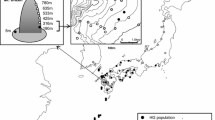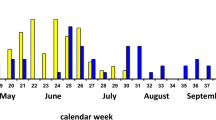Abstract
Episodes of isolation and secondary contact among populations of insects of Nearctic origin during Pleistocene glacial/postglacial climatic cycles had a strong evolutionary influence on the diversity of flies in the genus Rhagoletis in mountainous areas of Mexico. As a series of experiments undertaken to gather support for phylogenetic hypotheses on the origin of three walnut-infesting species in the suavis group, we examined pre- and postzygotic isolation between Rhagoletis completa Cresson, 1929 and R. ramosae Hernández-Ortiz, 1985. Despite morphological, biological, and behavioral differences, these two species were found to be capable of hybridization. Mating experiments in large enclosures revealed asymmetric sexual isolation. There were notable differences in male sexual behavior. While R. ramosae males mated exclusively on host fruit, R. completa males used fruit and alternative mating locations. During fruit-guarding and male-male contests, R. completa and R. ramosae males adopted markedly different wing postures. R. completa females were more reluctant to copulate with heterospecific males than R. ramosae females. During no choice crosses in small enclosures, there was a reduction of egg hatch for the hybrid cross of R. completa males × R. ramosae females. Our results and previous studies on reproductive isolation between other species pairs in the suavis group support a clade in which R. ramosae, R. zoqui Bush, 1966, and R. completa are close relatives all still capable of hybridizing.




Similar content being viewed by others
References
Bateson W (1909) Heredity and variation in modern lights. Pp. 85-101. In: Darwin and Modern Science. Cambridge University Press, Cambridge
Berlocher S, Feder JL (2002) Sympatric speciation in phytophagous insects: moving beyond controversy? Annu Rev Entomol 47:773–815
Brand CL, Kingan SB, Wu L, Garrigan D (2013) A selective sweep across species boundaries in Drosophila. Mol Biol Evol 30:2177–2186
Bush GL, Smith JJ (1997) The sympatric origin of phytophagous insects. In: Dettner K, Völkl W (eds) Vertical food web interactions: evolutionary patterns and driving forces. Springer-Verlag, Heidelberg, pp 3–19
Bush GL, Smith JJ (1998) The genetics and ecology of sympatric speciation: a case study. Res Popul Ecol 40:175–187
Bush GL (1966) The taxonomy, cytology, and evolution of the genus Rhagoletis in North America (Diptera: Tephritidae). Bull Mus Comp Zool 134:431–562
Bush GL (1968) Sympatric host race formation and speciation in frugivorous flies of the genus Rhagoletis (Diptera, Tephritidae). Evolution 23:237–251
Bush GL (1975) Modes of animal speciation. Annu Rev Ecol Evol Syst 6:339–364
Carvajal-Rodriguez A, Rolan-Alvarez E (2006) JMATING: a software for the analysis of the sexual selection and sexual isolation effects from mating frequency data. BMC Evol Biol 6:40
Coyne JA, Orr HA (1997) “Patterns of speciation in Drosophila” revisited. Evolution 51:295–303
Coyne JA, Elwyn S, Rolán-Alvarez E (2005) Impact of experimental design on Drosophila sexual isolation studies: direct effects and comparison to field hybridization data. Evolution 59:2588–2601
Cushman SA, Landguth EL (2016) Spatially heterogeneous environmental selection strengthens evolution of reproductively isolated populations in a Dobzhansky–Muller system of hybrid incompatibility. Front Genet 7:209
Dobzhansky TH (1937) Genetics and the origin of species. Columbia University Press, New York
Dobzhansky TH (1936) Genetic nature of species differences. Am Nat 71:404–420
Doellman MM, Saint Jean G, Egan SP, Powell TH, Hood GR, Schuler H, Bruzzese DJ, Glover MM, Smith JJ, Yee WL, Goughnour R, Rull J, Aluja M, Feder JL (2020) Evidence for spatial clines and mixed geographic modes of speciation for North American cherry-infesting Rhagoletis (Diptera: Tephritidae) flies. Ecol Evol 10:12727–12744
Domínguez-Domínguez O, Vila M, Pérez-Rodriguez R, Remón N, Doadrio I (2011) Complex evolutionary history of the Mexican stoneroller Campostoma ornatum Girard,1856 (Actinopterygii: Cyprinidae). BMC Evol Biol 11:153–173
Feder JL, Berlocher SH, Roethele JB, Dambroski H, Smith JJ, Perry WL (2003) Allopatric genetic origins for sympatric host-plant shifts and race formation in Rhagoletis. Proc Natl Acad Sci U S A 100:1034–1039
Feder JL, Xie X, Rull J, Velez S, Forbes A, Leung B, Dambroski H, Filchak KE, Aluja M (2005) Mayr, Dobzhansky, and Bush and the complexities of sympatric speciation in Rhagoletis. Proc Natl Acad Sci U S A 102:6573–6580
Feder JL, Powell TH, Filchak K, Leung B (2010) The diapause response of Rhagoletis pomonella to varying environmental conditions and its significance for geographic and host plant-related adaptation. Ent Exp Applic 136:31–44
Foote HR (1981) The genus Rhagoletis Loew south of the United States (Diptera: tephritidae). United States Department of Agriculture, Technical Bulletin Number 1607. 75p
Funk DJ, Nosil P, Etges WJ (2006) Ecological divergence exhibits consistently positive associations with reproductive isolation across disparate taxa. Proc Natl Acad Sci U S A 103:3209–3213
Fuller RC, Houle D, Travis J (2005) Sensory bias as an explanation for the evolution of mate preferences. Am Nat 166:437–446
Frey JE, Guillén L, Frey B, Samietz J, Rull J, Aluja M (2013) Developing diagnostic SNP panels for the identification of true fruit flies (Diptera: Tephritidae) within the limits of COI-based species delimitation. BMC Evol Biol 13:106
Glover MM, Egan SP, Hood GR, Rull J, Aluja M, Feder JL (2018) Phylogeography of Walnut-Infesting Rhagoletis suavis (Diptera: Tephritidae) Flies. Ins Syst Divers 2:1
Gripenberg S, Mayhew PJ, Parnell M, Roslin T (2010) A meta-analysis of preference–performance relationships in phytophagous insects. Ecol Lett 13:383–393
Headrick DH, Goeden RD (1994) Reproductive behavior of California fruit flies and the classification and evolution of Tephritidae (Diptera) mating systems. Stud Dipterol 1:194–252
Hedrick PW (2013) Adaptive introgression in animals: examples and comparison to new mutation and standing variation as sources of adaptive variation. Mol Ecol 22:4606–4618
Hewitt GM (2004) Genetic consequences of climatic oscillations in the Quaternary. Philos Transact Roy Soc Lond B Biol Sci 359:183–195
Hoskin CJ, Higgie M, McDonald KR, Moritz C (2005) Reinforcement drives rapid allopatric speciation. Nature 437:1353–1356
Howden HF (1963) Speculations on some beetles, barriers and climates during the Pleistocene and pre-Pleistocene periods in some nonglaciated portions of North America. Syst Zool 12:178–201
Howden HF (1969) Effects of the Pleistocene on North American insects. Annu Rev Entomol 14:39–56
Kaneshiro K (1976) Ethological isolation and phylogeny in the plan tibia subgroup of Hawaiian Drosophila. Evolution 30:740–745
Kaneshiro K (1983) Sexual selection and direction of evolution in the biosystematics of Hawaiian Drosophilidae. Annu Rev Entomol 28:161–178
Kasana A (1993) Developmental biology and phenology of the walnut husk fly, Rhagoletis completa Cresson (Diptera: Tephritidae) in the Willamette Valley of Oregon.PhD thesis.Oregon State University.
Knowles LL (2001) Did the Pleistocene glaciations promote divergence? Tests of explicit refugial models in montane grasshoppers. Mol Ecol 10:691–701
Koštál V (2006) Eco-physiological phases of insect diapause. J Insect Physiol 52:113–127
Linn C, Feder JL, Nojima S, Dambroski HR, Berlocher SH, Roelofs W (2003) Fruit odor discrimination and sympatric host race formation in Rhagoletis. Proc Natl Acad Sci U S A 100:11490–11493
Martin PS, Harrell BE (1957) The Pleistocene history of tempo rate biotas in Mexico and eastern United States. Ecology 38:468–480
Mayr E (1963) Animal Species and Evolution. Harvard Univ. Press, Cambridge, Mass
Michel AP, Rull J, Aluja M, Feder JL (2007) The genetic structure of hawthorn-infesting Rhagoletis for sympatric host race formation. Mol Ecol 16:2867–2878
Muller HJ (1942) Isolating mechanisms, evolution, and temperature. Biol Symp 6:71–125
Prokopy R, Papaj DR (2000) Behavior of flies of the genera Rhagoletis, Zonosemata, and Carpomya (Trypetinae: Carpomyina). In: Fluit flies (Tephritidae); Phylogeny and Evolution of Behavior. CRC Press, Boca Raton, Florida, pp 219–252
Provan J, Bennett KD (2008) Phylogeographic insights into cryptic glacial refugia. Trends Ecol Evol 23:564–571
Rolán-Alvarez E, Caballero A (2000) Estimating sexual selection and sexual isolation effects from mating frequencies. Evolution 54:30–36
Ross HH (1953) On the origin and composition of the Nearctic insect fauna. Evolution 7:145–158
Rull J, Prokopy RJ (2000) Attraction of apple maggot flies, Rhagoletis pomonella (Diptera: Tephritidae) of different physiological states to odour-baited traps in the presence and absence of food. Bull Entomol Res 90:77–88
Rull J, Aluja M, Feder JL, Berlocher SH (2006) The distribution and host range of hawthorn-infesting Rhagoletis (Diptera: Tephritidae) in Mexico. Ann Entomol Soc Am 99:662–672
Rull J, Aluja M, Feder JL (2010) Evolution of intrinsic reproductive isolation among four North American populations of Rhagoletis pomonella (Diptera: Tephritidae). Biol J Linn Soc 100:213–223
Rull J, Aluja M, Feder JL (2011) Distribution and Basic Biology of Black Cherry-Infesting Rhagoletis (Diptera: Tephritidae) in México. Ann Entomol Soc Am 104:202–211
Rull J, Tadeo E, Aluja M, Guillen L, Egan SP, Feder JL (2012) Hybridization and sequential components of reproductive isolation between parapatric walnut-infesting sister species Rhagoletis complete and Rhagoletis zoqui. Biol J Linn Soc 107:886–898
Rull J, Aluja M, Tadeo E, Guillen L, Egan S, Glover M, Feder JL (2013) Distribution, host plant affiliation, phenology, and phylogeny of walnut-infesting Rhagoletis flies (Diptera: Tephritidae) in Mexico. Biol J Linn Soc 110:765–779
Rull J, Tadeo E, Lasa R, Aluja M (2017) The effect of winter length on duration of dormancy and survival of specialized herbivorous Rhagoletis fruit flies from high elevation environments with acyclic climatic variability. Bull Entomol Res 108:461–470
Rundle HD, Nosil P (2005) Ecological speciation. Ecol Lett 8:336–352
Salomon M (2001) Evolutionary biogeography and speciation: essay on a synthesis. J Biogeogr 28:13–27
Schluter D (2009) Evidence for ecological speciation and its alternative. Science 323(5915):737–741
Schumer M, Rosenthal GG, Andolfatto P (2014) How common is homoploid hybrid speciation? Evol 68:1553–1560
Shepard DB, Burbrink FT (2009) Phylogeographic and demographic effects of Pleistocene climatic fluctuations in a montane salamander, Plethodon fourchensis. Mol Ecol 18:2243–2262
Smith JJ, Bush GL (2000) Phylogeny of the subtribe Carpomyina (Trypetinae), emphasizing relationships of the genus Rhagoletis. In: Aluja M, Norrbom AL (eds) Fruit flies (Tephritidae) phylogeny and evolution of behavior. CRC Press, Boca Raton, FL, pp 187–217
Solis DE, Morris AB, McLachlan JS, Manos PS, Soltis PS (2006) Comparative phylogeography of unglaciated eastern North America. Mol Ecol 15:4261–4293
Tadeo E, Aluja M, Rull J (2013) Alternative mating tactics as potential prezygotic barriers to gene flow between two sister species of frugivorous fruit flies. J Insect Behav 26:708–720
Tadeo E, Feder JL, Egan SP, Schuler H, Aluja M, Rull J (2015) Divergence and evolution of reproductive barriers among three allopatric populations of Rhagoletis cingulata across eastern North America and México. Ent Exp Applic 156:301–311
Tadeo E, Aluja M, Rull J (2018) Precopulatory mating and postzygotic isolation between two walnut infesting species of Rhagoletis from Mexican highlands. Ent Exp Applic In 166:713–723
Xie X, Michel A, Schwarz D, Rull J, Velez S, Forbes A, Aluja M, Feder JL (2008) Radiation and divergence in the Rhagoletis pomonella species grupo: inferences from DNA sequence data. J Evol Biol 21:900–913
Xie X, Rull J, Velez S, Forbes A, Michel A, Lobo N, Aluja M, Feder JL (2007) The bio and phylogeography of hawthorn-infesting Rhagoletis flies in Mexico and speciation mode plurality. Evolution 61:1091–1105
Acknowledgements
We are grateful to Emilio Acosta for assistance in fruit collections and pupal processing.
Funding
This work was partly funded by the Mexican Campaña Nacional Contra Moscas de la Fruta (Secretaría de Agricultura, Ganadería, Desarrollo Rural y Pesca-Instituto Interamericano de Cooperación para la Agricultura (to M.A.), Consejo Nacional de Ciencia y Tecnologia (CONACyT) special grant 1100/596/04 C-837-04 (to J.R.), and CONACyT CB 2005-25889-50008Q (to J.R.).
Author information
Authors and Affiliations
Contributions
JR and ET planed, designed, and executed experimental work; ET conducted data analyses; JR and ET wrote the manuscript.
Corresponding author
Additional information
Edited by Juliano Morimoto
Publisher’s Note
Springer Nature remains neutral with regard to jurisdictional claims in published maps and institutional affiliations.
Supplementary Information
ESM 1
(XLSX 20 kb)
Rights and permissions
About this article
Cite this article
Tadeo, E., Rull, J. Hybridization, Behavioral Patterns, and Pre- and Postzygotic Isolation Between Two Recently Derived Species of Walnut-Infesting Rhagoletis Fruit Flies in the Highlands of Mexico. Neotrop Entomol 50, 505–514 (2021). https://doi.org/10.1007/s13744-021-00865-3
Received:
Accepted:
Published:
Issue Date:
DOI: https://doi.org/10.1007/s13744-021-00865-3




